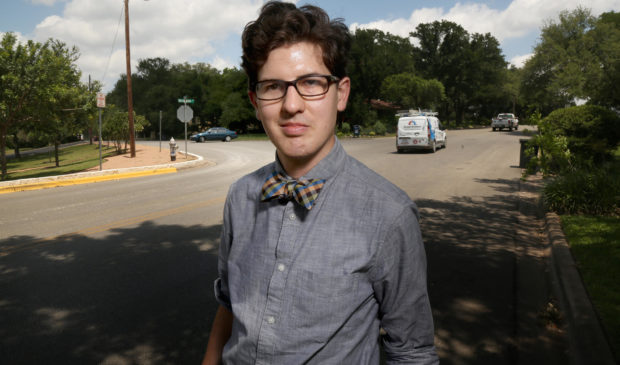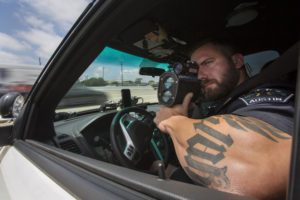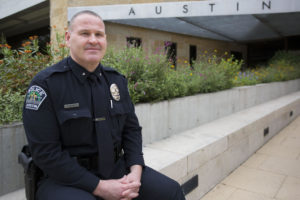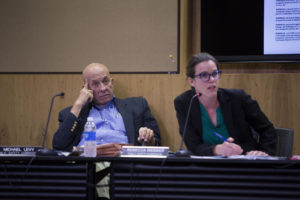Newsletter Signup
The Austin Monitor thanks its sponsors. Become one.
Most Popular Stories
- Council members celebrate unanimous defeat of bill that proposed putting Austin under state control
- A once-banned type of building is back in favor – and the Planning Commission approves
- City facing a $33 million deficit for 2026
- SOS suing state agency over failure to provide information on MoPac expansion
- Staffing isn’t the only thing to blame for Austin’s slow 911 response times
-
Discover News By District

To end traffic fatalities, Austin says it takes engineering, enforcement, education … and you
Friday, May 13, 2016 by Kate McGee
Francis Reilly is unique for an Austinite: He doesn’t have a car. He often rides his bike, but these days he mostly depends on the bus. To explain why, he met me at the intersection of Wallis and Rollingwood drives in Austin’s Rollingwood neighborhood west of MoPac.
“This is where I was hit by a landscaping truck about two years ago,” Reilly says, as cars whiz by us.
Reilly was on his bike when he was hit by a truck. The driver left the scene. Reilly had a concussion and broken bones. He recently had surgery on his shoulder because of complications from the crash.
Reilly says his crash has forever affected the way he gets around town, but he thinks about traffic safety every day anyway. He works in the Austin Planning and Zoning Department as a city planner and is one of the leaders on the city’s Vision Zero plan. The goal is to end all traffic fatalities in Austin by 2025.
Reilly says one major way to reduce traffic fatalities is through engineering. Just take the intersection where we met.
“Walking from the bus stop near MoPac to here, there are no sidewalks, so I’m walking on the street,” Reilly says. Adding more sidewalks would be an engineering change.
“And all these curves, and people are going pretty quickly,” he says, watching another car speed down the wide road. Adding speed bumps or other traffic-calming devices is another engineering change. Getting people to slow down could be as well, if the city could lower speed limits.
“A lot of it really does revolve around design,” Reilly says. “When we look at failure to yield for pedestrians, a high percentage of those crashes occurred on roads without sidewalks, for instance.”
About one-third of the Vision Zero plan recommends engineering changes: more sidewalks, lower speed limits and safer intersections.
“Everyone is going to make mistakes, and we need to design a system that makes sure they aren’t fatal. To them or anyone else,” Reilly says.
That idea is at the top of Austin’s Vision Zero plan. Vision Zero comes from Sweden, which created the first plan in the 1990s. Instead of adjusting humans to a city, through measures like education campaigns or enforcement of laws, Sweden said: Let’s engineer a system that works for humans, which includes safe streets and adequate public transit.
Austin’s Vision Zero plan says this, but it equally emphasizes enforcement and education as ways to reduce fatal car crashes, differing from the original Vision Zero philosophy.
What We Care About Is the Deterrence
Austin Police Officer Jason Borne has just pulled over a driver going 15 miles over the speed limit on 183 North. He’s with APD’s Highway Enforcement Unit. Borne chats with the driver for a bit before returning to his car, where I am sitting in the passenger seat.
“She got a ticket two weeks ago, so she was doing her best to plead for a warning,” Borne says, unpersuaded. As he talks, he prints out the speeding ticket in his car.
“There’s a segment (of the public) that just think of tickets as a revenue stream, right?” Borne says as he rips the printed ticket out of the machine. “We have no personal gain from writing this ticket. What we care about is the deterrence. If you got a ticket for speeding on 183 two weeks ago and that ticket is designed to deter you, but two weeks later you’re speeding on that same stretch of road, then why on earth would a warning deter you?”
Every day, Borne drives up and down Highway 183 north of Interstate 35, enforcing traffic laws in his domain.

APD Officer Jason Borne monitors Highway 183 north of I-35 for traffic violations. His boss, Commander Art Fortune, wants more money for enforcement in the city’s Vision Zero plan. CREDIT MIGUEL GUTIERREZ JR./ KUT NEWS
“There’s somebody assigned to North MoPac, someone assigned to South MoPac, and the other three are scattered on I-35,” Borne says, referring to the other Highway Enforcement officers currently on duty. The Highway Enforcement unit doesn’t have enough officers to cover Route 290 or 71, but there are patrol cars and cops on motorcycles who work the area. Highway Enforcement Commander Art Fortune, Borne’s boss, says that changes after the sun sets.
“The nighttime enforcement, other than my DWI units, is almost non-existent,” Fortune says. Fortune is one of the main players on the Vision Zero task force. He’s hoping Vision Zero will lead to more enforcement. To him, that means more traffic and DWI officers.
“Since we find that impairment is a major factor in a lot of those fatalities, it would only make sense to maybe increase the size of those units,” Fortune says. Fortune wants 18 additional officers, which would be expensive and could be an uphill battle after City Council rejected APD’s request for more officers last year.

APD Commander Art Fortune runs the department’s Highway Enforcement Unit and is one of the major players on the city’s Vision Zero task force.
CREDIT MIGUEL GUTIERREZ JR./ KUT NEWS
The Vision Zero plan also touches on another possible enforcement measure: change the way Austin police handle drivers whose licenses are suspended and those who don’t have licenses at all.
Right now, Austin police use a cite-and-release policy. They’ll write the driver a ticket for not having a license, but the driver gets to leave in their car. Fortune says instead of arresting the person on the spot, police could “take their vehicle away. Because the vehicle technically is the instrument that will end up getting you in a serious-injury crash or kill you.”
Last year, 34 percent of people involved in traffic fatalities were unlicensed or had a suspended driver’s license.
Educate the Public
The plan also recommends extensive education campaigns to alert people about the traffic fatality problem, creating an education team to lead these campaigns. Additionally, it suggests requiring all people who are cited for top contributing factors of traffic fatalities to take a driver’s safety course.
The report suggests the city hire cultural competence experts to make sure their campaigns are inclusive but doesn’t specifically address how to reach more isolated groups, like the homeless. It also recommends shortening the driver’s license renewal period from six to four years, something the city doesn’t have the power to do.
City planner Francis Reilly says people need to be aware of the risks and how the city is trying to end these fatalities.
“Raising awareness is really key to this,” Reilly says. “People all over (the) country get into their cars every day and don’t think about, ‘I could die’ or ‘I could kill someone.'”

Public Safety Commissioner Mike Levy listens to a brief presentation of the Vision Zero plan. Levy is concerned that the actions in the plan aren’t immediate enough.
CREDIT MIGUEL GUTIERREZ JR./ KUT NEWS
But not everyone agrees.
“Education is a soft thing. It means no one has to do anything,” says Mike Levy, a member of the Austin Public Safety Commission. “Education isn’t going to do anything today to turn around the number of fatalities and number of serious-injury accidents we’re having.”
Levy says he wants to see more immediate action taken. Instead, he says, the report lists too many goals and recommendations that take time to implement, and many of them don’t have a funding source.
“There’s no prioritization,” Levy says. “You have to have, ‘Well, these are three or four that can make a difference now.'”
Since last year’s record number of traffic fatalities, the city has started safety improvement projects at five high-crash intersections. According to the report, those are five-year projects that will cost $16.5 million overall. While the first year of funding is secured, the projects still need to be funded in the out-years. Many of the report’s other short-term goals could take up to three years, and lots of them still need funding. The long-term goals could take up to a decade.
By focusing on education and enforcement in the Vision Zero plan, it means the city of Austin believes human behavior can effectively be changed. That’s a philosophical stance that doesn’t fully align with that of the Swedish Vision Zero plan, which emphasizes the importance of infrastructure and engineering. But in Austin, even the engineers from the transportation department think the answer lies with behavioral, not structural, changes.
“Traffic safety solutions must be addressed holistically, and that’s really by education and culture change,” says Laura Dierenfield, manager for the Active Transportation Program at the Austin Transportation Department. “That education and culture change is one of the key underpinning principles, but also enforcement and prosecution, as well as land use and transportation engineering. All of those pieces are how we’re going to get to Vision Zero. And it’s really going to take the whole community to get behind it.”
Austin Needs YOU! to End Traffic Fatalities
On top of all of these “E” words city officials are throwing around, they say there is yet another one needed to make Vision Zero a reality: everyone.
“Because there’s decisions people make that can save their lives,” says Jim Dale, assistant director for ATD. “Some of that’s drinking and getting behind the wheel of a car. That’s really a behavior; that’s a decision someone made.”
Last month, Austin Mayor Pro Tem Kathie Tovo echoed that idea.
“Drivers and pedestrians are ultimately responsible for their own actions,” Tovo said. “I don’t want that piece to get lost in our conversations about the need to provide for alternative means and have parking meters that extend into the next day and others. I think we always need to be reminding people they need to make better choices, whether or not we’ve solved all these other issues.”
Nic Moe is a member of the grassroots organization Vision Zero ATX. He supports the Vision Zero plan, but disagrees with the idea that change rests on the personal responsibility of the individual.
“Personal responsibility is, of course, very important,” Moe says. “And it’s a total cop-out when we’re talking about a document like this. The way that we allow for personal responsibility to really work is to give people good options. And they don’t have those good options right now.”
This story is part of KUT’s series, The Road to Zero, which explores traffic deaths and injuries in Austin and the city’s plan to prevent them.
Top photo: Francis Reilly works in the city’s Planning and Zoning Department and is one of the main players on the Vision Zero task force. He was also hit by a truck biking in a residential area two years ago.
You're a community leader
And we’re honored you look to us for serious, in-depth news. You know a strong community needs local and dedicated watchdog reporting. We’re here for you and that won’t change. Now will you take the powerful next step and support our nonprofit news organization?





